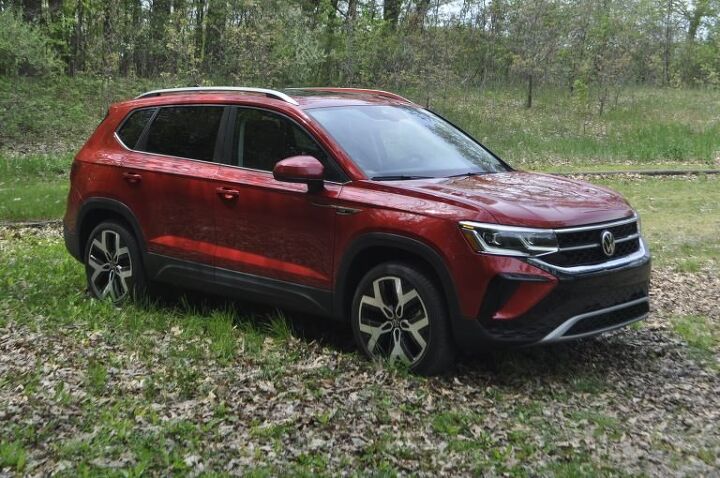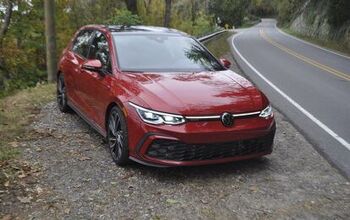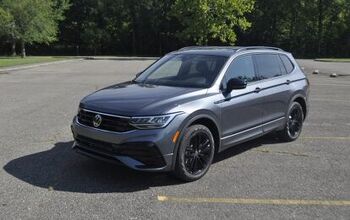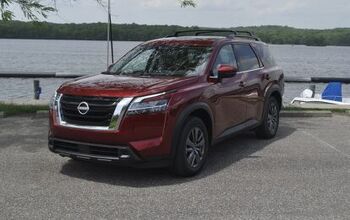2022 Volkswagen Taos First Drive - Fitting Right In

Standing outside a building that typically hosts weddings in downtown Chelsea, Michigan, a fellow auto journalist and I chatted through our masks about how it’s getting harder and harder to write about crossovers, because so many of them are just in that happy middle – not particularly great, and certainly not bad.
Add the 2022 Volkswagen Taos to that list.
The Taos shares the MQB platform with a lot of the VW lineup, including the compact crossover Tiguan. The Taos slots in one size below, with the Subaru Crosstrek and Kia Seltos in its sights.
Having spent time on the same drive loop in both front-wheel and all-wheel drive versions, I can tell you that the newest VW crossover is just, well, fine.
What it is not, at least not from a product sense, is a replacement for the outgoing non-GTI/R Golf.
I asked about that during a virtual briefing before I hoofed it to Michigan and VW management types said that yeah, the Taos is meant to replace the Golf. And from a purely business perspective, that makes sense.
But if you think that the Taos is a raised version of the Golf, which also uses the MQB platform, let me disabuse you of that notion right now. It looks, feels, and drives more like a shrunken Tiguan than it does a Golf.
That’s not a bad thing. The Tiguan is a perfectly pleasant, if not overtly sporty, machine. The Taos does feel a tad sprier than the Tiguan, but otherwise, it’s a pretty standard commuter crossover.
(Full disclosure: VW hosted me for dinner and put me in a hotel so that I could sample the Taos.)
Regardless of which drivetrain layout you pick, there’s just one engine choice: A 1.5-liter turbo-four that makes 158 horsepower and 184 lb-ft of torque. Front-wheel drive Taos models get an eight-speed non-DSG automatic, while AWD models get a seven-speed DSG automatic.
On the road, the FWD model felt a bit sportier than the heavier AWD model, and a bit more responsive to throttle input. Our drive loop wasn’t super challenging – it consisted mostly of relatively gentle corners – so the Taos didn’t need to sweat too much, but it did seem to hold its own when pushed. When pushed a bit too hard body roll exhibited itself and the tires got a bit squealy, but as is usual, I need to point out few crossover buyers will be that aggressive with this machine.
VW has given more heft and tightness to its steering in this application, and that’s good. I found the ride acceptable, even on broken pavement, erring on the side of stiff.
Acceleration was far from bonkers, but it felt good enough for the daily grind. Both cars did struggle a bit with one quick uphill after a stop sign, with the heavier AWD model struggling more. That model seemed a bit more hesitant to downshift and the throttle response felt slightly slower, at least in that one specific spot.
All-wheel-drive versions do get drive modes, and predictably, the Sport mode tightens up the steering and livens up throttle response while also making shifts more aggressive. It also felt, to me, as if the ride stiffened a bit, though VW tells me that engaging the Sport mode doesn’t change the suspension.
The biggest dynamic flaw was noise – specifically tire noise, though some wind noise intruded, too. The tire noise provided a deep rumble that wasn’t easily covered by cranking the tunes. Perhaps it was a tire/pavement mismatch, but regardless, the volume level was high, especially considering this is a family crossover, not a sports car.
Inside, you get the familiar all-black VW interior that prioritizes function over style, though it’s now dressed up with digital gauges. Everything is logically placed and easy to use, though one of the cars I drove – the AWD model, I think – seemed to have an issue tuning XM radio via the knob. It just skipped over stations that I could otherwise call up via direct tune.
Roominess and comfort are pluses – even the backseat didn’t feel too cramped for this over-large editor when I hopped back there to shoot pics. I had no trouble getting a good driving position set, and visibility is good.
There are three available trims – S, SE, and SEL. Both the FWD and AWD cars I drove were SEL models, with the FWD SEL priced out at $32,685 and the AWD model at $35,835. Base pricing is $22,995 for front-wheel drive and $25,040 for all-wheel drive. None of those prices include the $1,195 destination fee.
Standard features on S include cloth seats, 17-inch wheels, LED lighting all around, Apple CarPlay, Android Auto, digital gauges, USB ports, Wi-Fi, push-button start, automatic headlights, black roof rails, and climate control.
Available features on S include heated front seats, front assist, blind-spot monitor, rear-traffic alert, adaptive cruise control with stop and go, lane assist, travel assist, emergency assist, light assist, heated steering wheel, and rain-sensing wipers.
SEs add 18-inch wheels, 8-inch infotainment screen, leatherette/cloth combination seats, satellite radio, wireless charging, wireless Apple CarPlay/Android Auto, remote start, keyless entry, heated front seats, front assist, blind-spot monitor, and rear-traffic alert as standard and panoramic sunroof, adaptive cruise, lane assist, rain-sensing wipers, travel assist, emergency assist, light assist, and heated steering wheel as part of the options list.
Choose the SEL and you get 18-inch wheels with FWD or 19s with AWD, LED adaptive projector headlights, illuminated grille, navigation, Bose audio, dual-zone climate control, heated steering wheel, rain-sensing wipers, leather seats, cooled front seats (AWD only), rear park distance control, adaptive cruise, lane assist, emergency assist, road-sign display, travel assist low with traffic-jam assist, and light assist. A panoramic sunroof is the only option.
Looking over the features list – which is not all-inclusive, I left some minor stuff out for the sake of brevity – I’d almost choose a loaded SE over the SEL because I could give up nav with CarPlay or Android Auto. The Bose audio and dual-zone climate controls, plus maybe the leather seats, are the only features that I’d struggle to sacrifice. Obviously, feature choice is subjective – but a loaded SE doesn’t give up much to the top-dog trim.
As for choosing between AWD and FWD, well, the AWD does give you the Sport mode but the FWD model did feel a tad more sprightly. Obviously, the AWD model will appeal to Snow Belters (despite the debate over how necessary it is for inclement weather) and those who plan to hit the trailhead (though the Taos’ off-road specs suggest it’s best not to traverse the more-challenging trails), but unless you really need it – or a Sport mode – the FWD model serves well enough.
Fuel economy is listed at 28/36/31 for FWD models and 25/32/28 for AWD cars.
The Taos manages to fit right in the middle of the class. It’s not quite as stylish as the Seltos – it has more-conservative looks than the Kia – or quite as trail-ready as the Subaru. It’s priced about the same as a three-cylinder, mid-trim Ford Bronco Sport, but it’s not as off-road-oriented as the Ford. It does, however, have a nicer interior in terms of materials and perhaps design.
It feels a tad quicker than a Chevrolet Trailblazer, if not quite as responsive in cornering. It feels a bit more upscale than a Jeep Compass but doesn’t offer an off-road trim.
And so on, and so forth. The Taos ends up be a well-rounded compact crossover SUV that does a lot right, but which isn’t notably sporty/stylish/off-road capable. It’s just fun enough to drive to stave off boredom, and NVH issues aside, it’s comfy for the commute.
That makes it, well, fine.
What’s New for 2022
The 2022 Volkswagen Taos is an all-new compact crossover.
Who Should Buy It
Those seeking to find a solid all-around compact crossover that does many things well but isn’t a specialist in any one category.
[Images © 2021 Tim Healey/TTAC]

Tim Healey grew up around the auto-parts business and has always had a love for cars — his parents joke his first word was “‘Vette”. Despite this, he wanted to pursue a career in sports writing but he ended up falling semi-accidentally into the automotive-journalism industry, first at Consumer Guide Automotive and later at Web2Carz.com. He also worked as an industry analyst at Mintel Group and freelanced for About.com, CarFax, Vehix.com, High Gear Media, Torque News, FutureCar.com, Cars.com, among others, and of course Vertical Scope sites such as AutoGuide.com, Off-Road.com, and HybridCars.com. He’s an urbanite and as such, doesn’t need a daily driver, but if he had one, it would be compact, sporty, and have a manual transmission.
More by Tim Healey
Latest Car Reviews
Read moreLatest Product Reviews
Read moreRecent Comments
- InCogKneeToe Wow, memories. My Parents have a Cabin on a Lake, I have a Plow Truck and Friends, access to Lumps (old tired autos). What happens? Ice Racing!. The only rules were 4 cylinder, RWD only. Many Chevettes were destroyed, My Minty 1975 Acadian Hatch Auto with 62,000kms, did also. Rad, Rad Housing etc. My answer, a 1974 Corolla Hatch 4 speed, the rest of the Vettes took offence and Trashed the Yota. It was so much quicker. So rebuttal, a 1975 Celica GT Notch, 2.2L 20R, 5 Speed. Needed a New Pressure ate but once that was in, I could Lap the Vettes, and they couldn't catch me to Tag me.
- 28-Cars-Later I'm not sure when it was shot, but I noticed most shots featuring a Ford are pushing the BEV models which haven't sold well and financially kicked the wind out of them. Is it possible they still don't get it in Dearborn, despite statements made about hybrids etc.?
- ToolGuy I watched the video. Not sure those are real people.
- ToolGuy "This car does mean a lot to me, so I care more about it going to a good home than I do about the final sale price."• This is exactly what my new vehicle dealership says.
- Redapple2 4 Keys to a Safe, Modern, Prosperous Society1 Cheap Energy2 Meritocracy. The best person gets the job. Regardless.3 Free Speech. Fair and strong press.4 Law and Order. Do a crime. Get punished.One large group is damaging the above 4. The other party holds them as key. You are Iran or Zimbabwe without them.












































Comments
Join the conversation
SEL trim appears to be an appalling value for money as far as the powertrain goes - with your $35k fully-loaded SEL AWD you get the same engine as the $22k base, with 30 fewer horsepower than the $23k base CX-30, never mind the $31k 250-hp Turbo AWD.
So, which trim comes with the color-changing paint option? Just wondering for a friend of mine, whose hobbies totally do not include robbing banks.